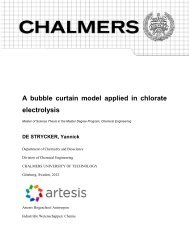A computational grammar and lexicon for Maltese
A computational grammar and lexicon for Maltese
A computational grammar and lexicon for Maltese
You also want an ePaper? Increase the reach of your titles
YUMPU automatically turns print PDFs into web optimized ePapers that Google loves.
<strong>Maltese</strong> today is still Semitic in origin, but differs considerably from other neo-Arabic languages<br />
as it has been heavily influenced by Romance languages <strong>and</strong> English. It is the national<br />
language of the Republic of Malta, <strong>and</strong> its official language together with English. Since 2004,<br />
<strong>Maltese</strong> has also been an official language of the European Union. <strong>Maltese</strong> is spoken by 90%<br />
of the roughly 400,000 inhabitants of the <strong>Maltese</strong> isl<strong>and</strong>s, as well as by some smaller expatriate<br />
groups around the world.<br />
1.1.2 Overview<br />
This section provides a very brief overview of the <strong>Maltese</strong> language. For complete, in-depth descriptions<br />
of the language refer to Azzopardi (2007), Brother Henry F.S.C. (1980) <strong>and</strong> to Spagnol<br />
(2011) <strong>for</strong> an in-depth look at morphology.<br />
Alphabet<br />
<strong>Maltese</strong> is the only Semitic language to use a Latin alphabet, with some minor additions. The<br />
complete alphabet consists of 30 letters (including two digraphs), split into 6 vowels <strong>and</strong> 24<br />
consonants:<br />
a b ċ d e f ġ g għ h ħ i ie j k l m n o p q r s t u v w x ż z<br />
The vowels in <strong>Maltese</strong> are: a e i ie o u. Vowels at the ends of words sometimes take the<br />
grave accent, <strong>for</strong> example università (‘university’) <strong>and</strong> Ġesù (‘Jesus’). The circumflex can used to<br />
indicate vowel length as in sâb (‘he found’), but is in general omitted in st<strong>and</strong>ard orthography.<br />
All consonants are considered strong/sound (sħaħ), with the exception of j <strong>and</strong> w which are<br />
weak (dgħajfin). The coronal consonants (konsonanti xemxin; opposite: qamrin) are the subset<br />
which assimilate with the article: ċ d n r s t x ż z. The liquid consonants (or sonorants<br />
(Fabri, 2009)) are those which assimilate with a prefixed ‘n’: l m n r. Together with għ, the<br />
liquids require the addition of epenthetic vowels during conjugation.<br />
Morphology<br />
Nouns inflect <strong>for</strong> number, which can be singular, dual, collective, or plural (though all <strong>for</strong>ms<br />
tend not to exist together). Animate nouns also inflect <strong>for</strong> gender (e.g. spiżjar/spiżjara, ‘male/female<br />
pharmacist’), while others have an intrinsic gender. Plurals may be either sound (external)<br />
or broken (internal); some nouns have both, e.g. tapit (‘carpet’) → tapiti, twapet (‘carpets’).<br />
Adjectives behave similarly to nouns, but have only a singular <strong>and</strong> plural (which is often<br />
broken as in the case of nouns). They have positive <strong>for</strong>m, a comparative which may be <strong>for</strong>med<br />
either morphologically or syntactically, <strong>and</strong> a superlative obtained by prefixing the definite<br />
article: kbir (‘big’), ikbar (‘bigger’), l-ikbar (‘the largest’).<br />
Verbs inflect <strong>for</strong> tense (mood/aspect), person (P1 sg/pl, P2 sg/pl, P3 sg m/f, P3 pl) <strong>and</strong><br />
polarity. They often take enclitic pronouns as direct <strong>and</strong> indirect objects. Many verbs have a<br />
2















